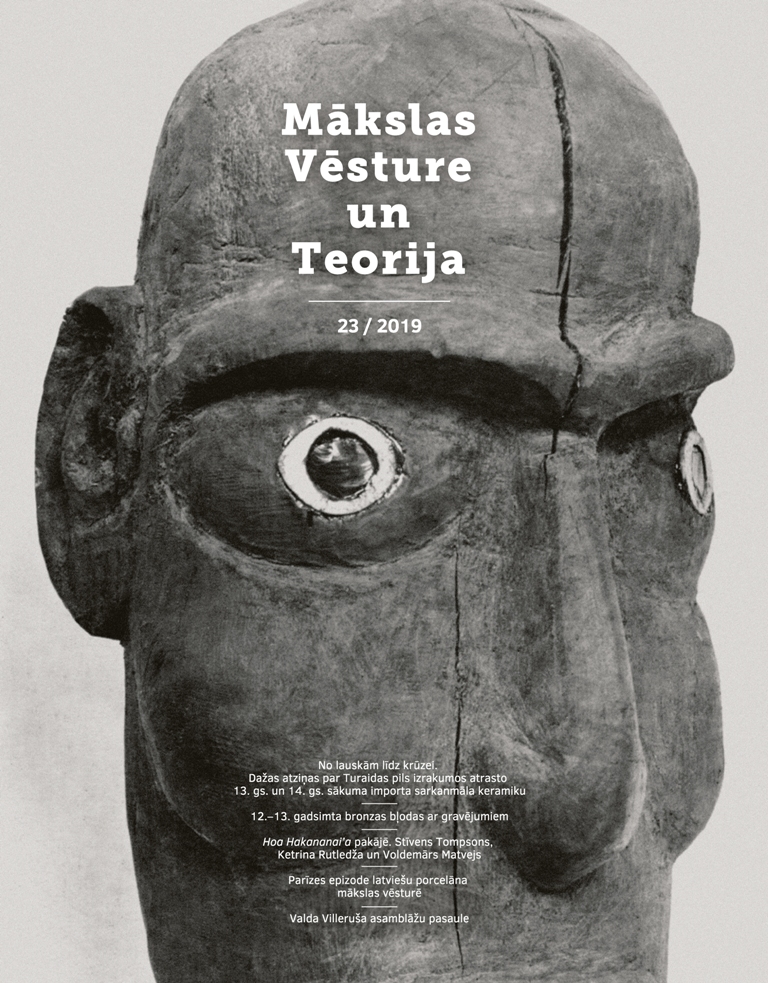Parīzes epizode latviešu porcelāna mākslas vēsturē
Parisian Episode in the History of Latvian Porcelain Art
Author(s): Dace ĻaviņaSubject(s): Visual Arts, History of Art
Published by: Mākslas vēstures pētījumu atbalsta fonds
Keywords: Porcelain painting studio Baltars; Romans Suta; Aleksandra Beļcova; Sigismunds Vidbergs; Erasts Šveics; Porcelain art; International Exposition of Modern Decorative and Industrial Arts;
Summary/Abstract: The porcelain painting studio Baltars (1924–1931) as the first internationally recognised accomplishment of Latvian interwar-period art has been actively studied in recent years; however, there are still various problematic aspects and information that needs to be concretised. The studio is mainly associated with the creative group consisting of its initiator, artist Romans Suta (1896–1944) as well as Aleksandra Beļcova (1892–1981) and Sigismunds Vidbergs (1890–1970). Less is known about the creative achievements of some other Latvian artists related to Baltars. One of the main catalysts in the establishment of Baltars was the invitation from France to participate in the International Exposition of Modern Decorative and Industrial Arts in Paris in 1925. It was the first international exhibition organised after the First World War and artists were eager to show the results of their creative work to a wider audience as well as to prove their right to join Europe’s “old” cultural nations. Various obstacles hindered a well-considered and balanced selection of exhibits. The Ministry of Foreign Affairs completed the process at the last moment, choosing works for the Paris exhibition without a jury and without listening to the participating artists’ opinions beforehand. Ethnographic fabrics, folk gloves and embroideries alongside Suta’s and Vidbergs’ painted vessels and Jānis Muncis’ (1886–1955) stage design models for the Daile Theatre were selected in a great hurry. This motley assortment had to familiarise the Parisian public with the new state and popularise Latvian applied arts. The art show was funded by the state of France and one can say that the interests and aims of the organisers and participants differed. The organisers wanted to assert French superiority in the production of luxury goods and strengthen France’s leading position in fashion that had been questioned in the new post-war reality. The exhibition was also a unique opportunity to present the new nation states that had just become independent to the “old Europe”; Latvia was not unique here, as its neighbours Soviet Russia and Poland also deserve mention. The main task at the Paris exhibition was to emphasise Latvia’s cultural identity, clearly demonstrating the difference from both the states Latvia once belonged to and its new neighbours. At the conclusion of the show on 26 October 1925, a festive awards ceremony for foreign participants took place in the hall of the Grand Palais in Paris. So far, there has not been precise information on how many Latvian artists were awarded and in what nominations. The number of prizes that Baltars artists received as well as their nominations varies in both memoir literature and art historians’ publications. In the end it was possible to clarify this issue by examining the official list of the exhibition awards – Liste de recompenses. The Baltars studio and its artists received two gold medals – one for the studio itself and another for the artist Sigismunds Vidbergs, while Romans Suta was awarded the bronze medal.Incredibly, regardless of the small number of works and ill-chosen exposition location and manner, the painted porcelain of the Baltars studio managed to attract the attention of professionals. Latvian periodicals reported that the press of France and other countries featured very positive reviews of the contribution of Baltars products without, however, mentioning specific publications. Confirmation was found in the previously unexamined illustrated catalogue of the Paris exhibition. Baltars porcelain features there alongside the Soviet Russian agit porcelain, the few foreign items whose photographs the exhibition organisers had selected for publication. A previously unknown painted plate with an industrial landscape can be seen in the picture among Vidbergs’ works. It was difficult to identify its author. While studying the heritage of Baltars, a painted porcelain plate in subdued tones with a wavy rim surfaced in a foreign private collection. It was similar to the one in the exhibition catalogue – the size was the same and the authentic Baltars logo was there, but it was not signed, therefore, the issue of authorship remained unresolved. While information was gathered about the participation of Baltars in the 1930 Riga Artists’ Group exhibition in Sweden, the archive of the Karlstad Museum provided materials, including the catalogue and photographs of exhibits. Along with the reproductions of Baltars plates, a photograph of Erasts Šveics’ (1895–1992) painting was also sent. The painting’s theme and composition was almost identical to the painted plate. Therefore, it was possible to confirm earlier assumptions of Šveics’ participation in the Paris exhibition and establish the authorship of one particular exhibit. Recently the author came across the information about a plate painted by the master Dmitry Abrosimov (1892–1958) in 1930 (painting designed by Erasts Šveics) as well as decorated vases with an identical drawing produced by the Burtnieks studio (1929–1939) in line with the Art Deco trend. This testifies to the fact that Baltars artists were part of the world art processes of the time and understood its topicalities in a similar way. These works are close to the plates by the prominent French ceramicist and glass artist, now already a design classic Jean Luce (1895–1964), exhibited in Paris in 1925. Studying and analysing artworks from the Paris exhibition catalogue’s ceramic and porcelain chapters, it becomes evident that the porcelain of Baltars stands out among the rest of the exhibits. Only the Soviet Union’s exposition of agit porcelain and the aforementioned artist Luce’s works bear some similarity to Baltars ware. It was probably their different and innovatory approach that earned these porcelain artists success at the significant 1925 International Exposition of Modern Decorative and Industrial Arts in Paris.
Journal: Mākslas Vēsture un Teorija
- Issue Year: 2019
- Issue No: 23
- Page Range: 43-55
- Page Count: 13
- Language: Latvian
- Content File-PDF

